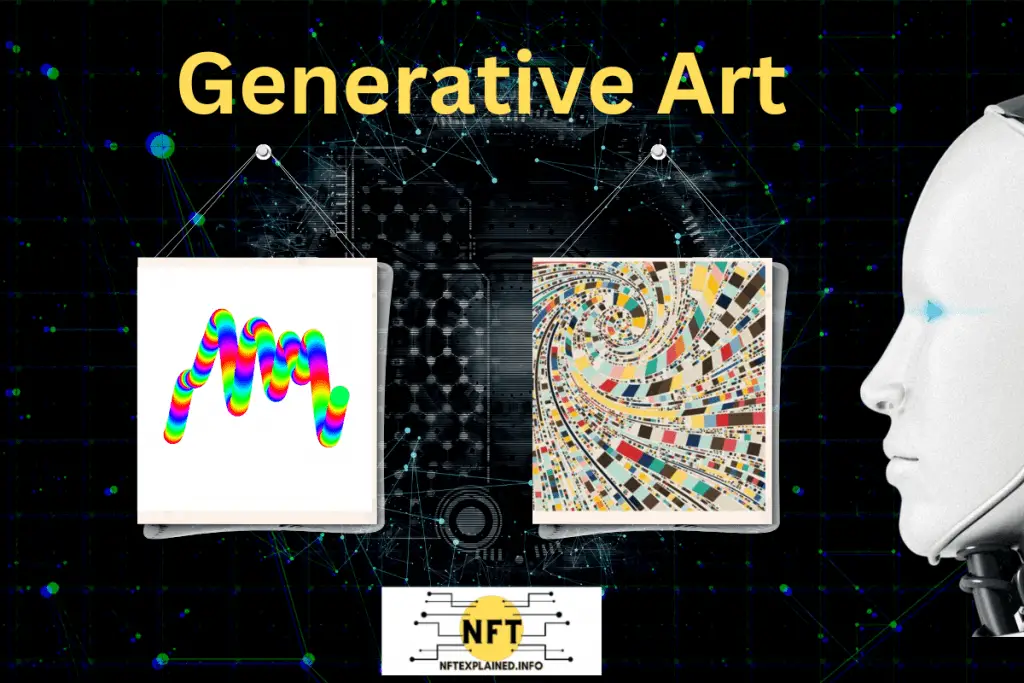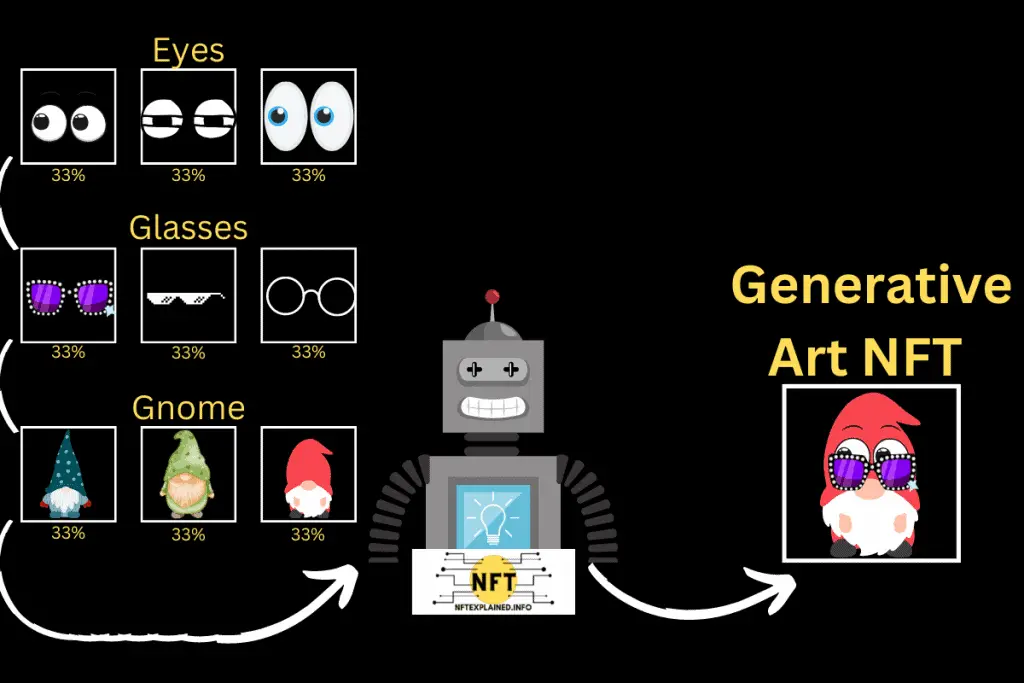
OpenSea, which is currently the largest NFT marketplace, has an array of different categories in which it attempts to classify NFTs – from domain names to utility NFTs. However, one category that is on the rise and not previously mentioned is generative art NFTs.
Many would say the real value of owning an NFT is the ability to verify ownership of the token or asset; this can essentially be done with any digital item (eg. artwork) that is minted on the blockchain. That being said, NFTs are created in a multitude of different ways, with one increasingly popular way being generative art.
So, what are generative art NFTs, how can people create them, and what are some of the top collections? Let’s dive in.
Generative art NFTs are created using unique aspects of art that are drawn by an artist and put together with AI – which is essentially computer code; combining these two aspects makes generative art. When computer code executes many images and they are minted on the blockchain, a generative NFT collection is made.
Most commonly with generative art NFT projects, an artist will create different traits that can be combined; however, all NFTs within that given collection will have some amount of similarity – allowing you to identify two NFTs from the same collection.
This is typically because computer code will execute a unique set of instructions in order for a collection to be created. For example, what is arguably the most widely recognized NFT collection – CryptoPunks – were created algorithmically using computer code.
While some CryptoPunks have rare traits like regular shades – which is a trait only 5% of the 10,000 Punks have – the collection can be readily identified by features that all Punks have. For example, all punks are facing the right, have a pixelated appearance, and have a single shade background color. These common traits make CryptoPunks readily identifiable at a glance.
Once the artist creates all traits (i.e. the hair, body, background, glasses, etc.) an algorithm will randomly select one of each trait. Typically, each image won’t be hand picked as there’s no way to ensure that a specific hair type will be placed with a specific background; however, the code will know to only have x% of images with a given trait. As an illustrative example, perhaps only 5% of the collection will have a gold background.
Think of this like putting each aspect of a person’s outfit into a washing machine and knowing that only one of each trait – specified by the code – will be pushed out. Here’s a simple illustration of this idea:

Now that our team has covered the fundamentals of how generative NFT collections are created, let’s take a look at some of the top generative NFT collections before diving into how to create this type of collection.
What Are The Top Generative NFT Collections?
Chromie Squiggles, Fidenza, and Autoglyphs are often thought to be top generative NFT art projects. Chromie Squiggles is widely recognized as a pioneer within the space as each NFT was created via computer code upon mint. Fidenza is widely recognized for its flow fields and Autoglyphs was one of the first to market.
Chromie Squiggles is considered the pioneer for generative art NFT projects; this collection of almost 10,000 NFTs created by Snowfro aka Erick Calderon – the founder of Art Blocks and Chromie Squiggles – has arguably solidified itself as a blue chip NFT. Amidst the bear market this collection sits around the 13 to 14 ETH price range and has enjoyed sales of up to 130 ETH or approximately US $200,000.

So what makes this project so unique, who is the founder, and what is Art Blocks?
Chromie Squiggles are unique in the sense that each NFT is generated at the time of mint; this means there is an actual script which generates random Squiggles based on a variety of different variables. This information is built into the smart contract and executed upon mint. There are so many different combinations that are generated; you can try for yourself – without actually minting – here.
Our team will link the actual source code for Chromie Squiggles here and we will link our article which covers how opensource the space is here.
The founder describes the work of Chromie Squiggles as, “exploring color and space through the language of computer code.”
Snowfro, who is the founder, discovered CryptoPunks all the way back in 2017 when gas fees were non-existent on the Ethereum blockchain; this event is what sparked his interest in NFTs and opened his eyes to new possibilities. He always had an interest in producing generative art and spent his free time practicing code – soon enough he put two and two together.
Snowfro or Erik Calderon as well as Jeff David created art blocks back in 2021; art blocks is a unique NFT platform that allows artists to create generative art and art that can change based on computation activity on the Ethereum blockchain.
Additionally, the site serves as a platform for artists to publish generative art – if chosen through the highly selective process. The creative code for each project allows for the changing of NFTs to a new iteration upon minting.
A unique project that has been on artblocks is Fidenza which was created by Tyler Hobbs. This collection is another that is widely recognized as a hallmark within the generative art NFT space.
Fidenza, which has 999 items and a floor price hovering around 90 – 100 ETH during a bear market, is described as Tyler Hobbs, “my most versatile algorithm to date. Although the program stays focused on structured curves and blocks, the varieties of scale, organization, texture, and color usage it can employ create a wide array of generative possibilities.”
The project is primarily created by what is known as “flow fields” which is something programmers are likely familiar with given they are into algorithmic work.
The algorithm allows for curves to be created in an aesthetically pleasing manner, in a way where they do not overlap, or collide. They are created based on factors like color and the sizes of blocks within each piece are created from a small size to Jumbo XL (which are huge and rare shapes).

The final generative NFT art project that is often talked about is Autoglyphs which was created by Larva Labs – the founders of CryptoPunks. This collection was also one of the first generative projects to store all its information on-chain.
With a limited 515 Autoglyphs ever released and historicality playing an aspect in the price, this collection sits around the mid 300 ETH price range (with regards to floor price). The collection also has an astounding 20,000 + ETH in volume traded.
Having all generative information being stored fully on-chain via the smart contract was undoubtedly an astonishing feat back in 2019.
Another project that our team thought should make it as a notable mention is Murat Pak’s Lost Poet NFT collection; this collection is quite complex and each NFT is uniquely generated by AI.

This project is intertwined with Pak’s previous projects; our team has a full article on this mysterious artist which we will link here.
Pak is a digital artist who is quite familiar with AI as this artist has created Archillect, a popular media account on Instagram, Twitter and Facebook that uses AI to post visual content likely to trend. Elon Musk follows the account on Twitter and has even teased a collaboration.
Now that we have a better understanding of how generative NFTs work, and some of the top collections – lets take a look at how to create NFTs within this style.
How To Create Generative NFTs Without Code
A unique website that allows you to create generative art using machine learning by simply typing in words – meaning without knowing any code – is snowpixel.app. Async is another good option that allows you to create without coding experience and allows you to set rarity percentages for a collection.
Snowpixel.app does require a small amount of money however you own the copyright to the images produced.
This type of website allows you to generate images for as little as US $10. Once the image is generated, you will be able to list it on marketplaces like OpenSea without any coding and be able to list it for free utilizing lazy minting.
Lazy minting is a process OpenSea uses where a digital asset is not minted or uploaded to the blockchain until it is purchased; this means that the creator will not have to pay for the gas fee (which is the price to mint).
SnowPixel has a pay as you go pricing model and allows you to buy images with crypto as well as by using a credit card.
While using snowpixel.app may be an optimal way to get the image for those looking to create an NFT, it is unlikely the NFT will sell as the marketplace works using supply and demand economics.
If an NFT is not providing utility to the purchaser, it is unlikely to be purchased. If you are looking for advice regarding how to sell NFTs our team sat down with top digital artists who gave their advice. We will link that article here.
Async is a platform designed specifically for web 3.0 creators; this site provides a range of unique features like rarity control, unique minting experiences – where the NFT is not revealed to a specific point in time, customizable mint pages, and more.
Some additional, unique text to image sites you may want to check out are Dall E 2 and MidJourney.
If you are more interested in doing some coding yourself, our team will provide some suggestions.
How To Create Generative NFTs (Using Code)
When it comes to creating generative art – for the purpose of NFTs or simply for the joy of creation – there are a number of good options. openFrameworks and Cinder are two great options for those looking to create using C++. Canvas-sketch is a good option for those looking to create with JavaScript.
openFrameworks is an open source C++ toolkit that makes it easier to create things using code. Additionally, openFrameworks is distributed under the MIT license, meaning that everyone can use the product as they please – in a commercial or non-commercial way (including being open or closed sourced post creation).
Another good platform for those looking to create using C++ is Cinder, which is a free and open source library for professional-quality creative coding.
Canvas-sketch is another option for those looking to create generative art in JavaScript and the browser. The tools of canvas-sketch can also be combined with graphic libraries and is specifically designed to help in creating artwork based on randomness and algorithms.
Now our team will cover the AI image generator that has gained massive popularity across social media.
What Is The Generative Art App Commonly Used On Social Media?
It appears everyone is now using a generative art tool to make themselves appear almost like a cartoon. Our team has seen some stunning portraits of people and that is exactly what we will cover in this section of our article.
Lensa AI: Photo & Video Editor is an app that allows for a range of different features including the creation of avatars which is a trend that has been exploding on social media. The app is free for a one week trial, after which it costs $8 a month with a $4 fee for the downloading of 50 avatars.
If you found our content helpful please consider following our team on Instagram, Twitter & TikTok! As well as subscribe to our YouTube!
Additionally, please consider supporting our team’s content creation through doing business with our partners: Trade stocks & crypto on Webull – get 2 free stocks. Buy a Ledger hardware wallet. U.S. users can get a crypto trading discount on Binance!
